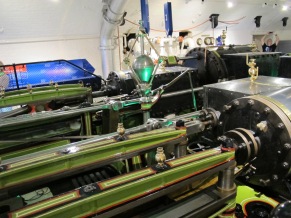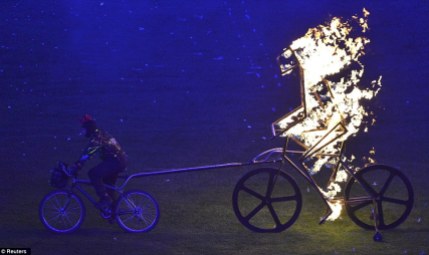The Science Museum, London

 This is definitely a must-see attraction for any Steampunk visiting London. The first exhibit you come to is called Energy Hall and features full-size steam engines and has interactive features that show you the physics of how they work and give the history of how they fit into the evolution of steam technology as a whole.
This is definitely a must-see attraction for any Steampunk visiting London. The first exhibit you come to is called Energy Hall and features full-size steam engines and has interactive features that show you the physics of how they work and give the history of how they fit into the evolution of steam technology as a whole.
But, the absolute best exhibit hall is Making the Modern world. It offers a veritable cornucopia of amazing inventions, including Charles Babbage’s Difference Engine No. 1 and a working model of a Victorian-era workshop run on a belt system.
Like the Museum of London, I would definitely recommend this as a great place to take people with mixed interests because the museum also has exhibits on the history of agriculture, real objects used in the early days of space travel and a “4D” cinema that has films on a wide range of topics.
The Museum of London

This institution has two different locations, but I only got a chance to make it to the one just north of the Millennium Bridge. (the other is at the seafront and focuses on the history of the docklands and shipping industry). The city of London has a very long history, so there is lots to see that doesn’t fit into my Steampunk theme, which can make it ideal for entertaining a group with varied interests. I loved the open format of the exhibits that allows visitors to meander through history, including one of the best displays on the everyday life during the Roman Empire that my Historian hubby has ever seen.
On the steamy side, there is tons to see. There was an amazing immersive exhibit about pleasure gardens like those that became popular during the 1800s. The darkened space features really cool period clothes, and videos that appear on the walls featuring people wearing them and acting out scenes. The mannequins are also sculptures in their own right and are lit according to what is being shown on the walls. The low light made it difficult to capture with a camera, especially because I didn’t want a flash to ruin the experience for other visitors, but trust me when I tell you it was captivating.
There is also a series of Victorian storefronts that you can walk through that are chockfull of period-appropriate merchandise and props. There is a big-wheel bike out in the open if you want a picture with one.
I also liked the displays of shoes, watches, and other technology that were strewn around in some of the other period sections. The exhibit on the suffrage movement was extremely well done, though I was shocked by a lot of what I saw. I had no idea how violent the pursuit of voting rights became in Britain. All in all, it is a wonderful museum with free admission and worth a whole day’s visit.
The Tower Bridge Part 3: The Inner Workings

 My favorite part by far of visiting the Tower Bridge was venturing into the engine rooms below street level. The green and black coal-powered hydraulic engines reminded me of a giant mechanical grasshopper ready to spring, and made the whole exhibition worth the admission fee. One of the biggest surprises for me during Steam Tour was how colorful some of these old engines are! If you are a fan of engines and haven’t seem my post about the London Museum of Water and Steam don’t forget to take a look.
My favorite part by far of visiting the Tower Bridge was venturing into the engine rooms below street level. The green and black coal-powered hydraulic engines reminded me of a giant mechanical grasshopper ready to spring, and made the whole exhibition worth the admission fee. One of the biggest surprises for me during Steam Tour was how colorful some of these old engines are! If you are a fan of engines and haven’t seem my post about the London Museum of Water and Steam don’t forget to take a look.
How it works: “When it was built, Tower Bridge was the largest and most sophisticated bascule bridge ever completed (“bascule” comes from the French for “see-saw”). These bascules were operated by hydraulics, using steam to power the enormous pumping engines. The energy created was stored in six massive accumulators, as soon as power was required to lift the Bridge, it was always readily available. The accumulators fed the driving engines, which drove the bascules up and down. Despite the complexity of the system, the bascules only took about a minute to raise to their maximum angle of 86 degrees.” From the Tower Bridge website.
For more information and pictures from my visit to the Tower Bridge, check out Parts 1 and 2.
The Tower Bridge Part 2: The Exhibition

 Visiting the bridge and looking at the outside is of course free, but visiting The Tower Bridge Exhibition within has a small fee. Visitors begin by going up into the top of the north tower where there is a short introductory video with a screen that blends into the Victorian era props around it. Afterwards you get to move into the tower and enjoy the historical and artistic exhibits on the East and West Walkways. I can’t say that the walkway exhibits were the highlight, but there was some interesting information about the history of bridge construction for “how does it work?” types. (You should go to their website for more info on what exhibits are currently on view.)
Visiting the bridge and looking at the outside is of course free, but visiting The Tower Bridge Exhibition within has a small fee. Visitors begin by going up into the top of the north tower where there is a short introductory video with a screen that blends into the Victorian era props around it. Afterwards you get to move into the tower and enjoy the historical and artistic exhibits on the East and West Walkways. I can’t say that the walkway exhibits were the highlight, but there was some interesting information about the history of bridge construction for “how does it work?” types. (You should go to their website for more info on what exhibits are currently on view.)
They recently installed glass floors on the West Walkway, but this was shortly after my visit in September 2014 so I didn’t get a chance to experience this aspect of the bridge. I can only imagine the incredible view onto the bustling street below, but I can vouch for the panoramic views of the city from the top of the towers!
But for me, the best was yet to come. As part of your exhibition admission, you also get to visit the engine room that used to power the raising of the bridge. So check out The Tower Bridge Part 3: The Inner Workings next time!
The London Museum of Water and Steam

 This is my pick for the best place on my entire Steam Tour to take your littlest Steampunks. There are fun, hands-on exhibits about the water cycle and great info about the history of harnessing the Thames and combatting the Cholera outbreaks through London’s history. But the most exciting parts of the museum complex is room after room of real, working steam engines. They don’t run every engine every day, but I was lucky enough to visit on a bank holiday when they did run every engine for at least 15 minutes at some point during their open hours.
This is my pick for the best place on my entire Steam Tour to take your littlest Steampunks. There are fun, hands-on exhibits about the water cycle and great info about the history of harnessing the Thames and combatting the Cholera outbreaks through London’s history. But the most exciting parts of the museum complex is room after room of real, working steam engines. They don’t run every engine every day, but I was lucky enough to visit on a bank holiday when they did run every engine for at least 15 minutes at some point during their open hours.
In the courtyard there are some smaller engines as well as a station to make giant bubbles in the afternoon, so that is another plus for kids. There is also a replica of a Victorian-era workshop where all the machines run on the same belt system (the original workshop was destroyed during the Blitz) and they offer tours.
Victoria and Albert Museum Part 2: The Clothes

The primary reason I wanted to visit the Victoria and Albert Museum was because I heard about the amazing displays of fashion through the ages. There is a really great circular gallery with men’s and women’s clothing, and right now there is also an exhibit on wedding dresses, though that has an extra charge where the rest of the museum is free. It would be a great place to do research for costumes, both to get visual inspiration as well as great background info. My best pictures were mostly of dresses, but there are lots of great suits, boots and hats for the menfolk as well.













































































































































